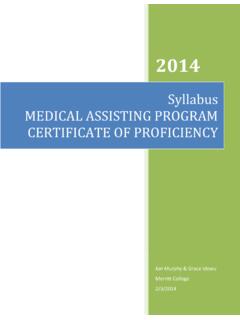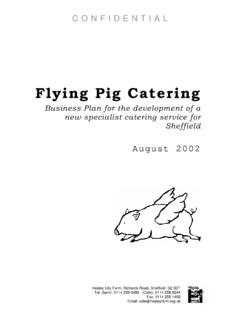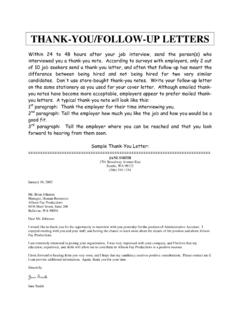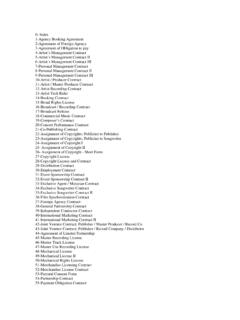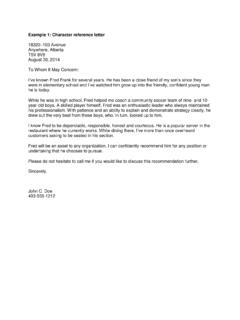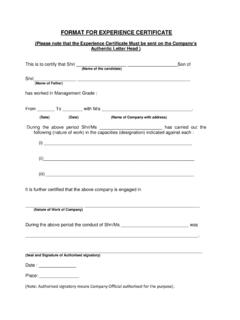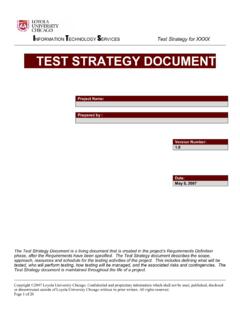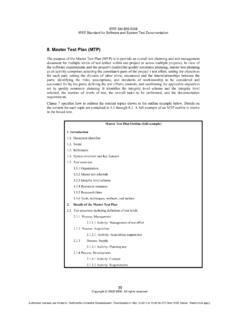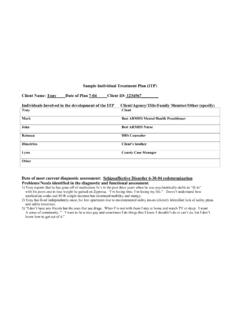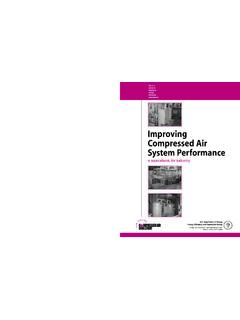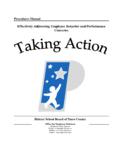Transcription of High School English Lesson Plan: Analyzing Essays
1 High School English Lesson Plan: Analyzing Essays Introduction Each Lesson in the Adolescent Literacy Toolkit is designed to support students through the reading/learning process by providing instruction before, during, and after reading/learning. Note that lessons incorporate the gradual release of responsibility model. When this model is used within a single Lesson and over several lessons, students are provided with enough instruction and guidance to use the literacy strategies on their own. The following Lesson includes some examples of explicit instruction and modeling, guided practice, and independent practice, but students need more practice and feedback than is possible within the context of a single Lesson . Bold print indicates a direct link to the Content Area Literacy Guide where readers will find descriptions of literacy strategies, step-by-step directions for how to use each strategy, and quadrant charts illustrating applications across the four core content disciplines.
2 The following Lesson plan and Lesson narrative show English teachers how they can incorporate the use of literacy strategies to support high School students to learn English content and concepts. The Lesson is designed for one block period (80 90 minutes) or two traditional classes (50 minutes). Instructional Outcomes NCTE Standards: 1. Students read a wide range of print and non-print texts to build an understanding of texts, themselves, and the cultures of the United States and the world. 6. Students apply knowledge of language structure, language conventions, media techniques, figurative language, and genre to create, critique, and discuss print and non-print texts. Content Learning Outcome: Through focused interaction and critical thinking with the text of selected Essays , students will see how literary devices and style conventions are used by authors to create interest or persuade readers to take their point of view.
3 Literacy Support Strategies and Instruction Before reading/learning: Coding (explicit instruction, teacher modeling). Materials: An excerpt from Carson's Silent Spring, projected by overhead or computer During reading/learning: Coding (guided practice). Materials: Text or class set of handouts with four environmental Essays that vary in style, length, and reading difficulty, such as Benjamin Franklin's The Whistle, Annie Dillard's In the Jungle, E. B. White's Cold Weather, Harry Crews' The Hawk Is Flying, Edward Abbey's Desert Images, R. J. Heathorn's Learn with BOOK, or a longer essay from John McPhee's Control of Nature After reading/learning: Coding Summary Template (explicit instruction, teacher modeling). Materials: Coding Summary Template drawn or projected on the front board The content for this component of CCSSO's Adolescent Literacy Toolkit was provided by Public Consulting Group's Center for 1.
4 Resource Management, in partnership with the Council of Chief State School Officers (August 2007). The content was informed by feedback from CCSSO partners and state education officials who participate in CCSSO's Secondary School Redesign Project. Before Reading/Learning (25 minutes). Literacy outcome: Students will learn how to identify literary devices and style conventions used by authors to convey point of view in Essays . Teacher preparation: 1) Review Silent Spring and select one or more excerpts to explicitly teach and model Coding. Prepare examples for each of the four literary devices authors can use to show point of view: information, description, persuasion, voice, and word choice. Think about what happens in your own mind when you read as you review literary devices or analyze how the author's style conveys a point of view about the environment.
5 Plan how you will convey your thinking to students so they understand how to analyze the text. Do not assume you can simply assign the coding task, even at the high School level. 2) If the literary terms information, description, persuasion, author's voice, word choice, and point of view have not previously been explicitly taught, prepare a handout defining each one. Teacher facilitation: 1) Tell students you will model a reading comprehension strategy called Coding that students can use to focus their thinking as they read. 2) Distribute a copy of the Silent Spring excerpt and project a copy while demonstrating to students how you code by making brief focused notes on the page of text. Explain that Coding helps the reader have a conversation with the text. The reader decides what to focus on and creates short codes to mark the text when the key elements are located.
6 Tell students that codes are created according to the purpose for reading and learning. The goal while reading the Silent Spring excerpt is to identify literary devices and style conventions the author uses to interest or persuade the reader about his or her point of view about the environment. 3) Review the four literary devices and style conventions that will be used to code the Essays . If the terms are already known, ask for volunteers to describe them and write a short definition on the board to activate student knowledge and provide support to all students for the Coding activity. If the literary terms have not previously been used in the course, provide a handout with definitions. 4) Distribute the Coding Template for use with the environmental Essays . The template is a full page so the code can be written directly across from the location of the text which is being coded.
7 If sticky notes are available, provide them as an option to the template page. Example of a Coding Template Essay Title: _____ Student Name: _____. Directions: You may use this page to mark the codes directly next to the sentence, phrase, or word you are marking. To use the insert page, place it in your book and write the page number at The content for this component of CCSSO's Adolescent Literacy Toolkit was provided by Public Consulting Group's Center for 2. Resource Management, in partnership with the Council of Chief State School Officers (August 2007). The content was informed by feedback from CCSSO partners and state education officials who participate in CCSSO's Secondary School Redesign Project. the top of the first column. Then place the code directly across from the part of the text you are coding.
8 Each time you read a new page, pull out this sheet to add codes for the next page. Use the following codes to interact with text as you read the essay: I = Information; D = Description; P = Persuasion; V = Author's voice or word choice showing point of view; ? = I don't understand/I have questions Page Page Page Page Page Page Page Page 5) Introduce the template to the class, explaining how to insert the page into the text selection and slide it out as they code each new page. 6) Read part of the first page of the Silent Spring essay aloud, pausing to explain what was happening in your own mind as you focused on identifying how the author used the literary devices to convey a particular point of view. Using the example you prepared: Model how to code in the margins on the projected image. Explicitly explain how you located key information, such as from the first or last sentence in a paragraph, by asking and answering a question related to a subheading, or by asking: What is the central message of this paragraph?
9 Show how you used cue words like who, what, where, when, how, and verbs like is to identify information. Discuss descriptive words by pointing out how a different tone would be created if a different adjective was used. For persuasion, point out cue words or phrases the author used to convince the reader: facts, data, emotional words, examples, slanted language, generalizations, etc. For voice and word choice, point out specific adjectives, adverbs, or unique expressions, such as humor, the author used to convey a specific point of view. 7) As you continue modeling and discussing how to code the excerpt from Silent Spring, invite students to identify places in the next sections of text where one of the codes applies. During Reading/Learning (35 minutes). Literacy outcome: Students will learn to identify literary devices and style conventions used by authors to convey point of view in Essays .
10 Teacher facilitation: 1) Tell students they will work in pairs to read and code an environmental essay. 2) Tell them each pair will select any one essay from four choices. Pass out the four Essays for students to preview. Briefly review each essay by summarizing the topic to build interest. The content for this component of CCSSO's Adolescent Literacy Toolkit was provided by Public Consulting Group's Center for 3. Resource Management, in partnership with the Council of Chief State School Officers (August 2007). The content was informed by feedback from CCSSO partners and state education officials who participate in CCSSO's Secondary School Redesign Project. Have pairs select one essay to read, discuss, and code together. 3) As students read and code, circulate to assist them. Informally assess their coding performance and provide assistance as needed.

